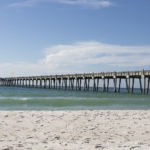UWF professor’s microbe research could come into play in oil spill aftermath
Microbial research at the University of West Florida in the past two decades could be a vital resource in the aftermath of continuing BP oil spill in the Gulf of Mexico.
UWF crews have been collecting water and sand samples from specific locations in the area for the past two weeks in order to establish a baseline for ongoing research of the spill, the result of the April 20 explosion off the coast of Louisiana.
“We are taking samples so we will have an idea of how much of the petroleum hydrocarbons might already be there and the types of microorganisms that are there,” said Joe Lepo, a UWF microbial physiologist. “Then, if this area is impacted by the oil spill, we will be better suited to study the degradation of the oil and the environmental effects of it.”
But the university’s research of water and sand from the Gulf of Mexico didn’t just start last month. In 1995, researchers identified two unusual, oil-eating bacteria – GOMEX2 and DF1 – both found naturally in the Gulf. While bacteria that can live off crude oil are common, these two particular microbes set themselves apart because of how effectively they produce biosurfactants. These biosurfactants act as dispersants, much like Dawn dish-washing detergent, to break up the very oil the bacteria devour.
These identified bacteria could be used to increase microbial activity in a spill-impacted Gulf and accelerate natural cleanup either by adding nutrients to increase bacterial presence or by introducing large, lab-grown quantities into Gulf waters. Biostimulation and bioaugmentation have been used with previous spills, though biostimulation is the more popular approach.
“These bugs are interesting because the biosurfactants they produce are absolutely amazing; they are better than anything we can make in the lab,” said Lepo. And as the oil’s presence decreases, so does the presence of GOMEX2 and DF1.
Over the years, several UWF students have earned their master’s degrees by analyzing these two particular microbes indentified through research at Sabine Island in the mid 1990s. Lepo named GOMEX2 and a UWF undergraduate research assistant, Diane Folse, named the other. There are eight patterns of each name but No. 2 of GOMEX and No. 1 of DF performed the best.
Lepo said the oceans contain thousands of oil-eating bacteria, such as GOMEX2 and DF1, which are constantly eating the crude oil seeping naturally from the ground underneath.
“What we have now is that the same amount of oil is leaking in a very small area. The rest of the time, the same amount is seeping out but it is distributed over the oceans,” he said.
The professor and researcher is confident that UWF could play a role in the spill’s aftermath, whatever route that might take.
“We have the expertise and the knowledge of how to monitor an oil spill and how to remediate it,” he said. “My feeling is we could learn a lot just by monitoring this in the coming years. For instance, we are still monitoring the Exxon Valdez.”
For more information, contact Lepo at (850) 857-6098 or e-mail jlepo@uwf.edu
By Susie Forrester, University Marketing Communications


